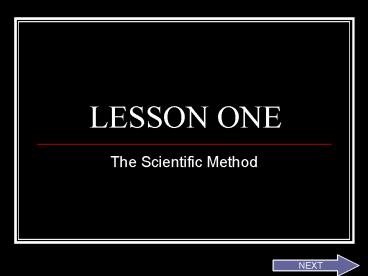LESSON ONE - PowerPoint PPT Presentation
1 / 20
Title:
LESSON ONE
Description:
LESSON ONE The Scientific Method NEXT Part 1: Scientific Method Review Watch the BrainPop video and complete your worksheet. You can pause and rewind the video clip ... – PowerPoint PPT presentation
Number of Views:59
Avg rating:3.0/5.0
Title: LESSON ONE
1
LESSON ONE
- The Scientific Method
NEXT
2
Part 1 Scientific Method Review
- Watch the BrainPop video and complete your
worksheet. - You can pause and rewind the video clip to help
you get your answers. - Take the quiz after the video and record the
correct answers on your worksheet.
NEXT
3
Part 2The Pizza Experiment
- Data Collection and Analysis
NEXT
4
Background
- It is Thursday and Brian is going to make pizza
tomorrow night for friends. The last time he
made pizza, the dough did not rise. He wanted to
know why, so he researched how yeast works. He
found that there was a connection between yeast,
sugar, and dough rising. To figure out the
connection, he designed an experiment to test the
effect of sugar on making dough rise. Brian
knows that the more CO2 that is produced by the
yeast cells during fermentation, the more the
dough will rise.
NEXT
5
Experimental Design
A
B
C
D
- Each bottle gets ¼ cup warm water and ¼ teaspoon
of yeast. - Put the following amount of sugar into each
bottle - A No sugar
- B ¼ teaspoon sugar
- C ½ teaspoon sugar
- D 1 teaspoon sugar
- Place a balloon over the top of each of the four
bottles to collect the CO2 given off by the yeast
going through fermentation. - Measure and record the change in the
circumference of each balloon at ½ hour intervals
for four hours.
NEXT
6
ResultsInitial Measurements (0 min.)Record
your results on your data table.
A
B
C
D
0 cm
0 cm
0 cm
0 cm
NEXT
7
ResultsMeasurements after 30 min. Record your
results on your data table.
A
B
C
D
0 cm
1 cm
2 cm
2.5 cm
NEXT
8
ResultsMeasurements after 60 min. Record your
results on your data table.
A
B
C
D
0 cm
2 cm
2.5 cm
3.5 cm
NEXT
9
ResultsMeasurements after 90 min. Record your
results on your data table.
A
B
C
D
0 cm
3 cm
3.5 cm
4 cm
NEXT
10
ResultsMeasurements after 120 min. Record your
results on your data table.
A
B
C
D
0 cm
4 cm
4 cm
6 cm
NEXT
11
ResultsMeasurements after 180 min. Record your
results on your data table.
A
B
C
D
0 cm
5 cm
6 cm
9 cm
NEXT
12
ResultsMeasurements after 210 min. Record your
results on your data table.
A
B
C
D
0 cm
5.5 cm
7.5 cm
14 cm
NEXT
13
ResultsMeasurements after 240 min. Record your
results on your data table.
A
B
C
D
0 cm
5.5 cm
9 cm
20 cm
NEXT
14
Analysis QuestionsAnswer the following
questions on your worksheetyour vocabulary words
have been linked to their definitions if you need
extra help!
- What is the independent variable in this
experiment? Why? - What is the dependent variable in this
experiment? Why? - Is there a control in this experiment? Explain.
NEXT
15
The control group in an experiment is the group
that nothing is done to. The control is left
alone so that the other variables may be compared
to it. The control is the variable that is
usually the "normal" result and that which you
are testing against. For example You are
testing whether temperature has an effect on the
breaking point of rubber bands. You take one
rubber band and put it in the freezer and another
is heated. A third rubber band is left at room
temperature. The one left at room temperature is
the control. It is the normal result you are
comparing your other two results to.
back
16
Data Analysis
- Use your data table to create a line graph for
the pizza experiment. - On your graph be sure to include
- A title
- Lines for each of the four bottles used
- A legend (key) to identify each of the lines
- Axes labeled with the appropriate variables,
scales, and units
Click here for hints on setting up graphs.
NEXT
17
ConclusionAnswer the following questions on
your worksheetyour vocabulary words have been
linked to their definitions if you need extra
help!
- What would you advise Brian to do to make his
pizza dough rise well? Support your answer with
data from the graph. - Define fermentation.
- What are some possible sources of error in his
experiment? Discuss at least 2.
NEXT
18
Part 3 Designing an Experiment
- In this last activity you are going to put to the
test all of the skills you mastered in part 1 2
to design your own experiment.
NEXT
19
Look very carefully at the picture
- In this optical illusion you should be able to
see both a beautiful young woman and an old hag. - Think about the following
- Which did you see first?
- Do you think everyone sees the same thing first?
- Does age make a difference to what you see first?
Does gender?
CLICK ON THE IMAGE TO SEE HINTS!
NEXT
20
The Old Hag
The Beauty
Hint She is looking over her right shoulder
away from you.
Hint She is looking down.
Nose
Mouth
Chin
Chin
Necklace
BACK
21
Designing an Experiment
- Develop an experiment to answer the following
question/problem - Does the age of the viewer make a difference in
whether he/she first sees the beauty of the hag
when looking at the optical illusion?
NEXT
22
In your experiment be sure to include the
following
- A hypothesis.
- Identify the independent variable.
- Identify the dependent variable.
- An experimental design.































